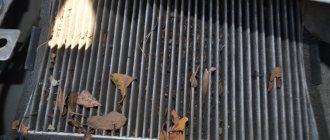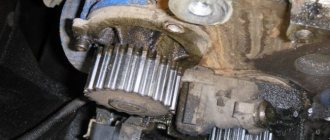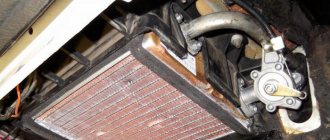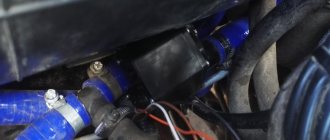In winter, my pepelats is not as warm as it should be. In this case, the fan works normally, judging by the air flow. The thermostat is most likely working, since the engine temperature reaches one hundred and ten, and the radiator fan turns on at the same time. The heater radiator couldn't have clogged up in three years, I think. What else can you sin on? Air lock? I have never had gurgling sounds anywhere.
I decided to touch the plastic heater flap lever. Sitting on the driver's seat, I crouched down and grabbed this lever with my right hand. He extended his left hand to the base of the windshield to feel the temperature of the air flow from the blower slots. At the same time, my ear ended up near the deflectors above my beard. My observation: When I pressed the lever, the sound in the deflectors changed. And the air became warmer. It's not like the air turned fiery. Of course not. But my hand felt the difference.
Now we need to figure out how to solve this problem. I don’t like the options that I saw during the drive, when they were tinkering with rubber bands and springs. The “shit and sticks” method is, of course, good... But I want to do it once and forget. Maybe someone has some ideas? Or has anyone already gone through this stage?
Yesterday after work I used the first spring I found.
The car's heating system must be in good working order regardless of the time of year. But many people think about this only when cold weather sets in. The efficient operation of the Lada Kalina heater ensures a comfortable stay in the cabin. The heating system does not fail so often, but timely maintenance is also important for it.
The design of the heating system Lada Kalina
The heater in a car transfers heat from the engine to the cabin. Without heating, the windows quickly fog up and become frosty in winter. On Kalina, the location of the stove allows for the possibility of integrating an air conditioner. The system is designed extremely simply and clearly, and is the same for models regardless of body type - station wagon, sedan or hatchback. It is shown schematically in the photo.
Heating system diagram
- The air duct exit is on the left.
- Air duct on the left.
- Windshield air ducts.
- Air duct distribution housing.
- Heater.
- Ventilation duct on the right.
- The air duct exit is on the right.
- Air duct for heating feet.
- Air duct for heating the interior.
- The air duct outlet is in the center.
The design uses the supply and exhaust circulation principle. Air enters the cabin, heated by the coolant, which simultaneously removes excess heat from the engine. The stove operates as a result of the radiator being heated by coolant. Then, with the help of a fan, the heated air flows through the air ducts through the deflectors into the car interior.
The heating system is controlled electronically. The volume of air masses that are heated from the heater radiator is regulated using a damper. On the center console there is an air conditioning control unit that controls the position of the damper and the speed of the electric fan.
The heater control unit consists of the following elements:
- Temperature regulator. By turning the knob, you can adjust the temperature of the air entering the cabin. Turning to the blue zone adds cold air, turning to the red zone adds hot air.
- Fan speed switch. It regulates the speed of air flow into the cabin.
- Air flow direction switch - to the windshield and down, only down to the feet, to the upper part of the cabin, to the windshield and side windows.
- Recirculation handle. Enables air circulation inside the cabin, while no air enters from outside. Can be used for a short time due to fogging of windows.
- Rear window defogger.
The control system also includes air duct deflectors. They can be closed or opened, and can also be used to regulate the direction of air flow.
What is the damper responsible for?
While the engine is running in the cooling system, the heated liquid moves through the heater radiator, while it heats the air flowing through it. The volume of air passing through the radiator and outside it is controlled by the main heater damper. Depending on how the temperature control knob is located on the dashboard, the amount of incoming air will depend.
You can distribute air movement throughout the cabin by turning the handle that regulates the position of the damper. But there are cases when the damper jams and it is impossible to properly regulate the flow of heat into the Kalina’s cabin.
If the problem is only with the valve, then you can correct the situation quite simply by tightening its cable. If after these actions the situation has not changed for the better, then you need to conduct a visual diagnosis of the condition of the mechanism and perform a number of simple steps.
Malfunctions of the Kalina heating system
The most common malfunctions of the stove are that the air flow is weak, only cold air comes in or not at all. Among the reasons why the stove on the Lada Kalina does not heat:
- Wear of the engine cooling system pipes. Antifreeze leakage due to worn hoses leads to a decrease in its level in the system, and therefore to insufficient heating of the heater radiator.
- The stove valve is out of order. This malfunction can be determined by the puddles of coolant that appear on the floor, under the front mats.
- The heating control unit is faulty. First, you should check the power supply from the on-board network. If it arrives, there is a problem in the air conditioning system. It is better to entrust unit repair to specialists.
- Wiring problems. There is no voltage supplied to the heating control unit. To check this, you will have to “ring” all sections of the chain.
- The additional resistor used to control the electric fan is faulty.
- The heater regulator is broken. In this case, it will be impossible to set a comfortable air temperature in the cabin.
- The radiator is faulty. One of the most common problems is that the Lada Kalina stove does not heat well. In the event of a breakdown, coolant leaks are typical. The part cannot be repaired.
What if you turn the standard radiator upside down?
So, friends, with the arrival of cold weather, I noticed that the stove was heating rather weakly, and at an outside temperature of -10°C, the windows thawed only after 30-40 minutes of intense traffic. It was impossible to drive like this, and during the next thaw I decided to start the third (I hope the last) replacement of the stove radiator.
By this time, I had come to the understanding that enough experimenting and I still needed to install the original heater radiator from Kalina. ideal in size and shape. Moreover, before installation, it must be carefully sealed with foam rubber so that the air from the fan passes through the radiator fins and not past it.
At that moment, I didn’t yet know how I was going to install a standard radiator, but I still didn’t intend to cut out the air ducts or disassemble the dashboard. It seemed to me that there must be some simpler and more logical way to install a standard radiator. Having purchased new pipes and a heater radiator from Kalina in advance (650 rubles), I removed the installed radiator from the gazelle and tried to install the standard radiator in its place.
After dismantling the radiator from the gazelle, I began to think about how to install a standard radiator without breaking anything. I twisted and turned the radiator, placed it this way and that way, and suddenly an idea came to my mind: what if we turn the heater radiator over with the fittings not towards the engine, but towards the driver?
The idea, although bold, was viable, so after 4 hours hot air was already blowing from the heating system deflectors. Now, let's look at the whole process of replacing the stove on Kalina from start to finish using the radiator reverse method. Let's start by making a list of everything we'll need.
Determining a malfunction in the cooling system
The first sign that something is wrong with the cooling system is a decrease in the level of antifreeze in the expansion tank. The amount of coolant should be constantly monitored. In a working system, its level should be maintained between the minimum and maximum marks. If the amount of antifreeze begins to decrease, the engine will heat up faster and the risk of overheating will increase.
On Kalina there is no engine temperature indicator, there is only a light on the instrument panel that signals the critical temperature of the coolant. If you have to add antifreeze frequently, you should look for the leak. If the hoses are broken, they can be replaced, just like the clamps.
The next thing to check is the circulation of coolant in the system. After starting the engine, you need to pay attention to the expansion tank. Impaired circulation may be caused by a faulty water pump (cannot be repaired) or a clogged cooling system - in this case it needs to be cleaned.
To diagnose the thermostat, you need to start and warm the engine to 70-75 ° C, then touch the lower radiator pipe. If it is cold, the coolant circulates only through a small circuit due to the thermostat valve being stuck in the closed position. This device is replaceable only.
If after a full check the fault is not found, the cause of the stove malfunction is an air lock. After removing excess air, the heater’s operation returns to normal.
How to choose the right heater radiator
| When the engine is running, heated fluid from the cooling system circulates through the heater core, heating the air passing through it. The amount of air passing through and around the radiator is set by the central heater damper, depending on the position of the temperature control knob installed on the instrument panel. |
The air distribution throughout the cabin can be adjusted by rotating the control knob for the air distribution flaps, as well as by turning the flaps and guide blades of the instrument panel ventilation grilles.
First of all, you need to pay attention to the metal from which the heating system element is made. Cheap options are made of aluminum
If it cracks, the owner has only one choice - throw it away and buy a new one.
Meanwhile, the brass-copper model, although more expensive, can be easily repaired - cracks in it can be easily sealed.
It is also important that the swirlers of the new radiator are made of durable plastic. As practice shows, such models last for many years and rarely become clogged.
Before choosing a stove radiator, you should know that they can be either aluminum or copper-brass. It is difficult to clearly prioritize the choice of one material, but each one has specific features of its work. These features are dictated by the properties of the material. Copper has a slightly lower thermal conductivity than aluminum, and therefore warms up more slowly. This cannot be said to be bad, since the thermal inertia of such a radiator is quite large. This means that it may not cool down for a long time.
We recommend: How to choose speakers for a car
An aluminum radiator is the opposite. It warms up quickly, but cools down just as quickly. It has a few more disadvantages. Firstly, the aluminum radiator cannot be repaired. Once it drips, you can throw it away. Copper is soldered quite simply and as many times as necessary. You just need to choose it correctly, because when selling, especially in the car market, you may come across a repaired copy with the partitions removed. It won't leak, but it won't provide heat either. Antifreeze will simply pass through such a radiator as if through a pipe.
The stove has a simple design. Its main element is the heater radiator. During the first 20-30 minutes, the engine heats the coolant to a temperature of 40-50 degrees, and then it circulates through the cooling system and enters the heater radiator. Warm air is distributed throughout the cabin using fans.
Each type, depending on the properties of the material, has its own advantages. The thermal conductivity of copper is less than that of aluminum, so it heats up more slowly. But it also retains heat for a long time. Copper products have high maintainability and can be soldered a large number of times.
Aluminum, on the contrary, heats up quickly and cools down quickly. The disadvantage of an aluminum radiator is low resistance to mechanical damage and non-repairability. If it leaks, it should be replaced. The advantage of aluminum devices is their low cost.
Swirlers in pipes
In any case, it is better to buy original products to avoid fakes. The car owner decides which radiator is best to purchase.
Checking heating system elements
If the heater on the Lada Kalina does not work - it blows cold air - it is better to look for the reason, starting with the simplest thing. You should not immediately disassemble complex components. Typically, most problems arise from minor problems.
temperature sensor
If only hot or, conversely, only cold air blows from the air duct nozzles, regardless of the position of the damper, the cause of the malfunction is the interior temperature sensor. It is located in the ceiling, in the lampshade. The problem is solved by replacing the sensor.
Heating fan
If switching modes and air flow speed does not produce anything (a whistle or crackling sound is heard, the fan begins to make noise), the malfunction is related to the electric fan. To check this, you need to do the following:
- Set the temperature control knob to the extreme blue zone position.
- After that, use the switch to change the fan speeds from first to fourth.
The air flow should become stronger as speed increases. If this does not happen, then the fan is faulty. If it works, but not in all modes, or the speed changes disproportionately, then the cause of the breakdown is a failed auxiliary resistor. The source of the problem may be a blown fuse F5 in the mounting block due to an open circuit in the power supply.
Heater damper
To check the heater damper on the Lada Kalina, you need to set the temperature control knob to the extreme position in the blue zone, and the fan speed switch to “maximum”. Then you need to turn the damper control knob and at the same time monitor how the direction of air mass flow changes. If nothing happens, this indicates a malfunction of the damper regulator or the damper is stuck in one position (the traction cable has come off).
Let's sum it up
The heating system is simple. Timely diagnostics can save the owner of a LADA Kalina from unexpected breakdowns; the heater circuit will also help with this. Monitor the level of antifreeze, change it according to the regulations, and the system radiator will serve its regulated life, delighting you with warmth and comfort in the cabin.
Depending on the configuration, the layout of the Lada Kalina stove may vary. In one case, the design of the ventilation and heating system is simple and reliable, in the other, temperature control in the car interior is controlled by automation and electronics. Let's look at the operating principle of the Lada Kalina heater in different modifications.
DIY heating system repair
To change this or that part of the heating system, it is not at all necessary to seek help from specialists. This will help save time, but not money. If you follow the recommendations, you can replace some system components yourself.
Heater fan
Even beginners can replace the Kalina stove fan. The main problem is its location. For this reason, most of the time is spent not replacing the part, but dismantling it.
Fan replacement with panel removal
The method is recommended by AvtoVAZ engineers, but it is not the simplest. Not everyone decides to use it in a regular garage. When performing work, you must follow the instructions:
- First, turn off the power to the on-board network by disconnecting the battery terminals.
- Drain all coolant and remove the cabin filter.
- After unscrewing the fastening nuts, lower the steering column to its lowest position.
- Release the brake light switch from the wires, unclip the clips, and remove the upholstery from the pillars.
- Unscrew the screws and remove the front panel (cladding), then remove the dashboard along with the deflectors.
- Now you can begin dismantling the fan. To do this, you need to disconnect the terminal with wires from it, remove the ventilation hose, and unscrew the fastening nuts.
After installing the new fan, all further actions are carried out in the reverse order of dismantling. The procedure requires attention and accuracy and takes a lot of time. At some points, the help of a second person will be required.
Replacing a fan without removing the panel
It is not practical to remove the entire dashboard just because of the heater fan. You can replace the device without removing the dashboard - you just need to lift its right side. Next, you should “arm yourself” with a knife and a flashlight and crawl under the panel. The noise insulation is cut off, the fasteners are unscrewed, and replacing the Kalina stove motor becomes much easier. This method will significantly save time and nerves, although it will create some inconvenience.
Before you start replacing the electric fan, you need to make sure that this particular device is faulty.
Replacing the temperature controller
To dismantle the part and replace it, it is necessary to remove the control unit assembly. The procedure looks like this:
- the on-board network is de-energized by removing the “negative” terminal from the battery;
- the radio tape recorder (if any) is removed, and the terminal block of wires is unhooked from it;
- the damper control lever is removed;
- Next, the handle for controlling the temperature and direction of air flow is dismantled;
- there are plugs located at the bottom of the control unit - they need to be removed and the fastening screws underneath must be unscrewed;
- the center console should be carefully pulled towards you;
- After removing the console, disconnect the terminal blocks from the switches.
Heating system modifications
Every owner of a Lada Kalina is faced with the need to modify the stove. The upgrade usually involves installing a new 6-hole thermostat, a coolant filter element, and a different heater valve. Many, given the mediocre performance of the pump, install an additional water pump. There are many ways of minor tuning that can be used to achieve improvements for greater comfort.
Increase in operating temperature
This method is suitable for Lada Kalina with an electronic gas pedal. Previously, the throttle valve, which was heated by a common cooling system, was controlled by a cable drive. After installing the electronics, the hose that went for heating was looped into the cooling system.
To upgrade, you will need a tee, an additional hose and clamps. The second air duct is mounted as close as possible to the thermostat - the tee is installed in the coolant supply pipe to the radiator. The other end of the air duct is connected to the outlet of excess steam near the expansion tank fitting. Thanks to such a simple modernization, it is possible to increase the operating temperature to 92-95 ° C when the stove warms up from 50 ° C and above.
Installation of a hydraulic fence for drainage
A regular medical dropper is inserted into the channel of the steam outlet tube, which is immersed in antifreeze to the bottom of the expansion tank. As the liquid cools, obeying the law of physics about communicating vessels, it will begin to be drawn into the steam outlet, preventing the possible formation of air plugs - airing. Thanks to this simple method, the stove will begin to heat much more efficiently, which means the interior will be warmer.
You can also change the clamps to more reliable ones - self-tightening ones, and ordinary rubber hoses - to silicone ones. To reduce heat losses, it is worth taping all the joints of the air ducts, but to do this you will have to dismantle the panel again. The most convenient way to do this is when troubleshooting a problem.
Regular removal and installation of the dashboard will lead to its loosening, squeaks, knocks and other extraneous sounds will appear coming from under the panel while driving.
Adjusting the heater damper
To get to the heater damper, you will have to disassemble part of the front panel - unscrew the center console. This is where the stove control unit is located. You will need to remove the ashtray and two plugs under the hazard warning button. There are two self-tapping screws that need to be unscrewed. All knobs and switches are removed from the control unit. When releasing the latches, the console must be pulled out towards you, and then all the wires behind it must be disconnected.
Often the cause of damper malfunction is wear and breakage of the mounting of its drive. If it is not possible to replace the part, use epoxy glue and seal the broken mount. It may be broken due to the drive cable being too tight. In this case, you will have to develop it manually - usually this is enough to avoid similar problems in the future.
It is better to start adjusting the damper position by adjusting the stove tap. The bracket holding the cable sheath should be removed from its body. After this, you can remove the cable from the crane. Turn the tap lever to the maximum open position and remove the old cable. In fact, the heater tap may not be closed at all in the future.
FakeHeader
Comments 66
Hello! Tell me, have you tried heating this damper? Could it be due to the temperature, well, the “Yagodka” is 10 years old, I also started noticing that the heating has become worse But I have a “climate” and the damper is not a cable one. Everything is fine with the SOD
Unfortunately I haven't tried it. In theory it should be heat resistant.
On my damper there is a type of soft rubber around the edge from the factory. It is pressed tightly against the radiator.
It’s not on this damper, I had them on all of them except this big and yellow one.
Hello! The one on the right, from grants or K2, the last picture, “bottom” And where is the damper, did you get hold of it?!
Two left Kalina 1, right Grant. I bought the damper in a place with a heater that was broken, for 700 rubles.
Yes, with the Kalinovskaya stove it’s just white, and actually with SOD. They got smart in the design department with SOD. It’s like winter and there’s only so much talk about SOD and the stove. True, this problem has passed me by. I immediately sharpened the rod on the thermostat and now the temperature is stable at 90. Instead of using springs to tighten the damper itself, I did something different on the damper control cable, I unscrewed it one turn at a time and now the damper fits all the way (although judging by your photos I already doubt that to end). But that’s not all, I put a piece of pipe of a smaller diameter into the pipe that goes to heating the throttle (Tobish reduced the cross-section of the pipe), which seemed to me to increase the pressure on the stove. The same thing goes after the remote control, but the cross-section of the reduced pipe is enough for a throttle Same for HBO, it was possible to mix something up with a tap instead of a tube, but I didn’t want to sweat and it turned out very well. At least in cold weather - 15, which is not so often where I live, the stove heats perfectly, HBO works perfectly, the temperature is stable 90 degrees.










